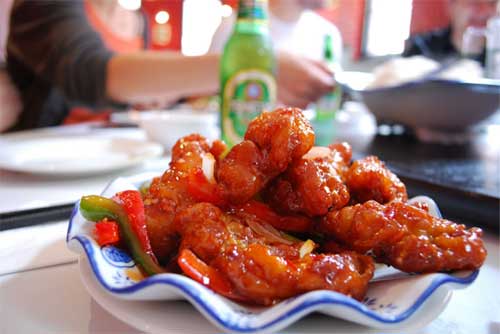Imagine stepping into a bustling marketplace in Beijing centuries ago. The air is thick with the scent of spices, the sounds of merchants haggling, and the vibrant colors of silks and porcelain. As you weave through the crowds, you notice a group of foreign traders, their clothes and mannerisms distinctly different from the locals. They are Westerners, and their presence in the heart of China signals a moment of historical significance. The Chinese, for centuries insulated from the broader world, were encountering a culture vastly different from their own. This encounter sparked a complex mix of fascination, suspicion, and eventual adaptation, shaping both Chinese and Western cultures in profound ways.

Image: www.huffingtonpost.com
The Chinese, with a long and rich history, held a deep-seated confidence in their own cultural traditions. Their view of Western culture was not entirely unidirectional, though. It was a dynamic process, influenced by their own perceptions, political context, and the changing dynamics of the world. This article explores the multifaceted perspectives of the Chinese on Western culture, examining the historical evolution of this relationship and the impacts on both sides. We’ll delve into the Chinese fascination with Western technological advancements, the anxieties surrounding Western colonialism, and the subsequent embrace of Western cultural elements that have shaped contemporary China.
Early Encounters: A Mix of Curiosity and Caution
The Arrival of Westerners: Traded Curiosity and Fear
Early Western interactions with China often revolved around trade. Portuguese and Dutch explorers, driven by the desire for luxury goods like silk and tea, forged relationships with Chinese authorities. However, these encounters were initially marked by caution and suspicion from both sides. The Chinese, comfortable within their own established order, viewed Westerners as strange and unfamiliar, their customs and behaviors often perceived as “barbarian.” The Westerners, on the other hand, were often surprised by the advanced civilization they encountered in China, a civilization that rivaled their own in many ways.
The Jesuit Missionaries: A Bridge of Learning and Diplomacy
In the 16th and 17th centuries, Jesuit missionaries arrived in China. These missionaries, skilled in science, mathematics, and astronomy, sought to convert the Chinese to Christianity. Their understanding of Western knowledge and their willingness to learn about Chinese culture allowed them to forge connections with the Chinese elite. Their presence helped to facilitate a limited exchange of ideas and knowledge between the two cultures. However, the missionaries’ attempts to convert the Chinese ultimately met with resistance, as they clashed with Confucian ideology, the dominant force in Chinese society.

Image: www.echinacities.com
Westernization and the Opium Wars: A Turning Point
The Rise of Western Power and the Imposition of Trade
The 18th and 19th centuries saw an increase in Western political and economic influence across the globe. Driven by the Industrial Revolution, Western powers sought new markets and resources, leading to the colonization of vast areas in Asia, Africa, and the Americas. China, with its vast resources and internal turmoil, became a prime target. The British, seeking to expand their trade in opium, a highly addictive drug, forced the Qing dynasty into a series of unequal treaties. These treaties granted Western powers extraterritorial rights, control over trade, and access to Chinese ports.
The Opium Wars: A Loss of Pride and a Desire for Change
The Opium Wars, fought in the mid-19th century, were a humiliating defeat for China. The Qing dynasty, weakened by internal strife and technological inferiority, was unable to resist the superior military power of the Western nations. The defeat exposed China’s vulnerability and sparked a period of intense introspection. Many Chinese intellectuals began questioning traditional values and systems, recognizing the need to embrace modernization and strengthen the nation. Western technology, scientific advancements, and political ideas were seen as potential solutions to China’s decline. This era marked a shift in the Chinese view of Western culture, acknowledging the need to learn from the West to survive and thrive.
The May Fourth Movement: Rethinking Tradition and Embracing Modernity
A Quest for National Identity and Modernization
The May Fourth Movement, a student-led protest movement in 1919, was a turning point in Chinese history. It was sparked by the Treaty of Versailles, which awarded German concessions in China to Japan. This fueled widespread anger among Chinese intellectuals and youth who felt betrayed by the West. They saw the Western powers as hypocritical, promoting democracy and equality while perpetrating imperialism on the weaker nations. This period of intense nationalistic sentiment led to an increased emphasis on modernization. The Chinese intellectuals began to look westward for inspiration in areas of science, technology, and democracy.
A Complex Relationship: Borrowing from the West While Retaining Chinese Values
The May Fourth Movement ushered in a period of cultural and intellectual ferment. Chinese intellectuals grappled with the complexities of adopting Western ideas while preserving their own cultural identity. This struggle for a new, modern China was characterized by a desire to learn from the West while maintaining Chinese traditions and avoiding a complete Westernization. The movement gave birth to various schools of thought—some advocated for a radical change in societal structures, while others emphasized a gradual adaptation of Western ideas to Chinese circumstances. This complex and nuanced debate was essential in shaping the future of China.
The Aftermath of the May Fourth: Western Culture in China
A New Era of Exchange: From Imitation to Adaptation
Following the May Fourth movement, China entered a period of transformation. The communist revolution in 1949 signaled a significant shift in the Chinese political landscape. The new government, under Mao Zedong, initially adopted a cautious approach to Western culture, viewing it with suspicion as a symbol of capitalist and bourgeois values. Yet, the desire for modernization and technological advancements remained strong. The Chinese government embraced Western technology and industry, establishing universities, research institutions, and factories modeled after their Western counterparts.
The Cultural Revolution: Clashing Ideologies and a Period of Isolation
The Cultural Revolution, a turbulent period that lasted from 1966 to 1976, brought radical changes to Chinese society. It was marked by an intense focus on political ideology and a suspicion of foreign influences. The government promoted radical leftist ideas, and Western cultural elements were often vilified and suppressed. This period of isolation slowed down the pace of Western influence, but it also paved the way for a new wave of cultural liberalization in the decades that followed.
Modern China: A Unique Blend of Western and Eastern Influences
Reopening to the World: Embracing Economic Growth and Cultural Exchange
After the tumultuous Cultural Revolution, China underwent a period of rapid economic growth under Deng Xiaoping’s leadership. The government adopted a policy of “reform and opening up,” fostering economic reforms, attracting foreign investment, and re-engaging with the global community. This period saw a massive influx of Western products, ideas, and cultural influences into China. Western brands, fashion, music, and movies became increasingly popular, blurring the lines between Western and Chinese culture.
A Complex Landscape: Cultural Hybridization and the Search for Identity
Contemporary China stands at a fascinating crossroads. It is a society that has embraced Western technology and economic models while still clinging to its own cultural traditions. This creates a complex and dynamic cultural landscape, where Western influences are integrated into Chinese society, creating unique hybrid forms of cultural expression. The rise of Chinese pop culture, with its blend of Western and traditional elements, showcases this dynamism. At the same time, there is a growing awareness of the need to preserve Chinese cultural heritage amidst the rapid influx of Western influences.
The Chinese Viewed Western Culture As
Conclusion: A Journey of Mutual Influence
The journey of Chinese perspectives on Western culture is a long and complex one, marked by periods of curiosity, resistance, and eventual adaptation. From early trade encounters to the embrace of Western technology and culture in the modern era, the relationship between China and the West has shaped both civilizations. While the Chinese have readily adopted Western technologies and economic models, they have also been wary of the potential for cultural imperialism and have strived to maintain their own unique cultural identity. Ultimately, the relationship between China and the West is a testament to the power of cultural exchange, demonstrating how even seemingly disparate cultures can influence and shape each other in profound ways. As China continues to rise as a global power, understanding its complex relationship with Western culture remains crucial to navigating a world where intercultural interactions play an increasingly important role.






